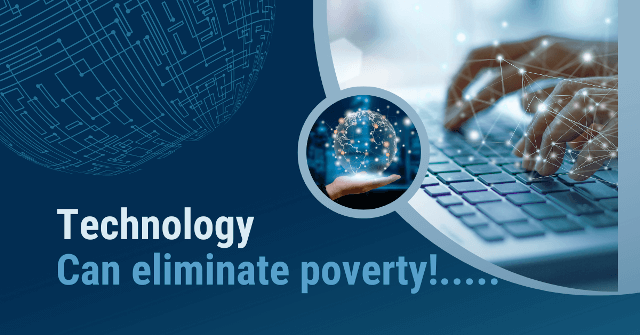“The onset of COVID-19 dealt a heavy blow to our world, and for the first time, the masses realized the crucial role of technology and digitalization. With nearly the entire planet confined to their homes, people heavily relied on the Internet and technology to meet their needs.
The 20th century ushered in a technological explosion, and the surge in digitization brought about improved living standards for the global middle class, promoting healthier lives compared to their analogue predecessors.
However, despite these technological advancements, the harsh reality is that inequalities have persisted in recent years. The world’s wealthiest make up only a minuscule one percent, while the majority, a staggering 90 percent, find themselves in the ranks of the poor. This divide extends beyond wealth and touches upon disparities in education and healthcare.”
Uber Tractor: Transforming African Agriculture
Technology continues to play a pivotal role in enhancing the daily lives of numerous individuals. An illustrative example of this is the introduction of the “Uber Tractor” service in Africa. This amazing tractor has been a significant boon for farmers who cannot afford the luxury of owning their tractors.
In regions where manual farming methods are the norm, productivity often lags significantly behind modern urban farms. The “Hello Tractor” app has emerged as a game-changer allowing farmers to easily rent mechanized farming equipment. It has drastically boosted productivity, achieving up to 40 times faster results than manual labor helping through technology to eliminate poverty.
This App is a provider of state-of-the-art agricultural machinery for rent and now operates in 13 African countries. This remarkable initiative has positively impacted the lives of over half a million farmers, enabling them to significantly accelerate crop production.
China’s Drone Revolution
In the pursuit of poverty alleviation through technology, China’s remarkable journey stands as a shining example. With increasing internet accessibility, digital services have the potential to foster significant growth in even the most underserved regions. The Chinese government has spearheaded numerous programs, focusing on infrastructure development and providing support to empower individuals in the technology field.
One such instance of technology making a significant impact is the widespread adoption of agricultural drones across China. These drones have become a game-changer in the farming industry. They efficiently spray fields with pesticides and fertilizers, covering an impressive 12-15 hectares in a single day, a stark contrast to the laborious 4 hectares achievable by manual labor. This advancement not only boosts agricultural productivity but also creates new job opportunities.
The surge in demand for agricultural drones has been astonishing, with sales reaching 15 thousand units in 2020, a remarkable increase from a mere thousand in 2017. This technology offers a glimmer of hope, paving the way for more prosperous and profitable farms in China. This example is showcasing how technology can be a pivotal tool in solving the challenge of poverty. This will attract the young blood towards the farming. Thus it would increase the chances to boost the economy in a longer Run.
The Smartphone Revolution
The potential of smartphones is undeniable, with over three-quarters of all mobile internet users residing in developing countries. Additionally, it has been observed that 82% of the world’s population now enjoys 4G connectivity, highlighting the role of technology in alleviating poverty within our society.
In the global landscape, 4G networks have expanded their reach, covering 82 percent of the world’s population. The advent of 5G technology is revolutionizing lives, especially for farmers and small-scale businesses, enabling them to tap into the vast e-commerce market and boost their product sales. Rural residents, who once faced insurmountable barriers to accessing larger markets, can now showcase their agriculture and handicraft products online, generating revenue and sales.
Empowering Education through Technological Advancements
The advent of remote learning gained significant traction during the COVID-19 pandemic, leading to a profound reconfiguration of educational prospects and delivery methods. This shift in educational paradigms has democratized access to learning, making it accessible to individuals across various age groups, whether they are young learners or adults acquiring digital skills for enhanced earning opportunities. Technology has paved the way for providing educational opportunities to the underprivileged sectors of society.
The internet, particularly platforms like YouTube, has become a treasure trove of knowledge, offering a plethora of lectures and tutorials on a wide range of topics. Acquiring education, conducting research, or mastering a new skill has become more accessible than ever, akin to a walk in the park.
China has emerged as a trailblazer in the realm of digital education, especially in rural areas where employment opportunities were once limited. Notably, 52% of the rural population in China is now actively acquiring digital skills, thereby increasing their chances of expanding product sales not only within the local market but also on a global scale. By focusing on providing quality education, there is a remarkable potential to combat poverty globally through digitalization.
Conclusion
The influence of technology in society is long lasting, specifically in the context of poverty reduction cannot be underestimated. The Covid-19 was a turning point, underscoring the significant role of technology in our day to day lives. While the digital age has increased the chances of improving living standards, the inequality still persists as long as the wealth distribution still exists.
Despite these challenges, the change is inevitable with the remarkable strides in using technology as a force for good. Whether it is the “Uber Tractor” or the drone revolution, these are the prime examples of how technology harnesses to empower the lives of underserved areas and enhance productivity and capabilities.
Additionally, with the rise of smartphones and the expansion of 4g And 5G networking the academics and employment are unlocked, particularly in the developing countries.
In the future, technology guarantees promising prospects in alleviating poverty. By identifying the digital divide, fostering innovation and promoting inclusive reach, collective work can lead the world towards a brighter future and it will become a silver bullet against poverty.
Frequently Asked Questions
Can technology alone eliminate poverty?
Although technology plays a pivotal role in poverty alleviation, I cannot be the sole solution. Addressing poverty is a multidimensional challenge. While technology plays a significant role in poverty alleviation, it cannot be the sole solution. Addressing poverty is a multifaceted challenge that involves not only technology but also policy, education, healthcare, and economic opportunities. Technology can serve as a powerful tool to create opportunities and bridge gaps, but it must be integrated with broader social and economic strategies.
What are some examples of technology-driven initiatives to combat poverty?
Initiatives like the “Uber Tractor” service in Africa, China’s agricultural drone revolution, and the expansion of 4G and 5G networks in developing countries are notable examples of how technology is being harnessed to alleviate poverty. These innovations have improved agricultural productivity, expanded market access, and empowered individuals to access educational resources, ultimately contributing to poverty reduction.
How can we ensure that technology benefits the most marginalized communities?
To ensure technology’s benefits reach the most marginalized communities, it’s crucial to address the digital divide by expanding internet access and digital literacy programs. Governments and organizations must prioritize inclusive policies and infrastructure development, especially in underserved regions. Additionally, fostering innovation and entrepreneurship can create economic opportunities for disadvantaged populations.
Is digital education the key to eradicating poverty?
Digital education is a vital component in addressing poverty, as it can provide access to knowledge and skills that can lead to better economic prospects. However, it is not the sole solution. Combating poverty requires a comprehensive approach that includes access to quality healthcare, job opportunities, and social support systems. Digital education can complement these efforts by providing a pathway to better opportunities and upward mobility.




This stage is fabulous. The magnificent information uncovers the essayist’s excitement. I’m shocked and anticipate additional such mind blowing material.
Impressive posts.